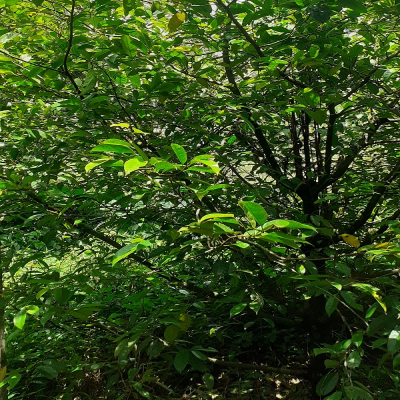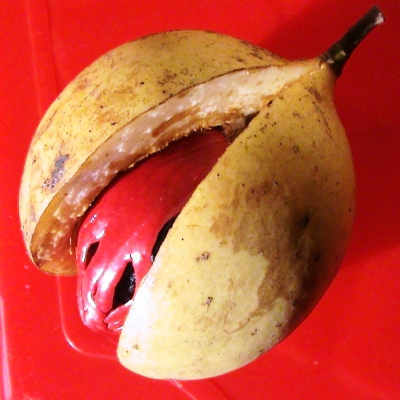Distribution and Habitat: Native of Moluccas, found throughout various localities of Kerala, Assam, Tamilnadu and some other state also.
Botany: An evergreen moderate sized aromatic tree with grayish black bark having lenticular spots on outside and red juice on the inner side.
- Leaves: Elliptic or oblong lanceolate, acuminate, shiny above dull beneath.
- Flowers: Creamy yellow, fragrant, in umbellate cymes, staminal column of male flowers stalked.
- Fruits: Yellow, globose or pyriform, pericarp fleshy, splitting in to two halves at maturity. Seed oblong, obtuse, testa shiny, aril yellowish red, irregularly lobed, extending to the apex of the seed.
Properties: The nutmeg and aril are bitter, aromatic, astringent, aphrodisiac, anti-inflammatory, anodyne, antipyretic, anthelmintic, deodorant, digestive, carminative, stomachic, expectorant, diuretic, emmenagogue, antispasmodic, febrifuge, narcotic, stimulant, ophthalmic, anticonvolucent, antiseptic, constipating and tonic
Chemical constituents: Dehydrodiisoeugenol, licarin B, lignans, and isolignans, aryl tetra hydrofuran, aryl propanoids, macelignan, 5’-methoxydehydrodiisoeugenol, pinene, d-camphene, dipentene, p-cymene, d-linalool, terpine-4-ol, geraniol, safrole, eugenol, iso eugenol, methyl eugenol, myristicin, myristic acid elemycin, trymyristin etc.
Uses: They are useful in inflammations, cephalalgia, helminthiasis, dyspepsia, flatulence, nausea, vomiting, diarrhoea, dysentery, colic, cough, asthma, neuralgia, lumbago, strangury, ulcers, impotency, skin diseases, freckles, cracks in feet and general debility.
Formulations: Aphenasava, jeerakarishta, Ratnagiri rasa, yakriti, manmathabhra, jathiphaladi churna, jadhiphaladi vatti.
Agro-technology:
Climate and Soil: Nutmeg requires hot and moist conditions, with 150-300 cm rainfall per annum. Areas with soils of clay loam, sandy loam and red laterite are ideal for its growth.
Propagation: The plant is propagated by seeds. Fresh seeds are collected from mature fruits
Manures and Fertilizers: Apply cattle manure at 10 kg/ pit and gradually increase to 50 kg/tree for 15 years old tree . Likewise fertilizers at 20:18:50 g N, P2O5 and K20/ tree in the first year is increased to 500: 250:1000g in the fifteenth year.
Irrigation: Regular watering is necessary for good germination.
Pests and Diseases: Shot hole caused by Collectotrichum gloeosporioides, leaf blight and fruit rot by Botryodiplodia theobromae, leaf spot by Alternaria citri, sooti mould caused by Pharmocapinus betle and horse hair blight are the common diseases
Harvesting: Seedling trees start bearing in 7-8 years while grafts start bearing in 4 to 5 years. They yield up to 60 years. The fruits take 9 months from flowering to harvest. When the fleshy rind of the nut splits open, the fruits are fully ripe for picking. It is then allowed to dry slowly in the sun for 10-15 days.
Processing: Essential oil is extracted from seed, mace, leaves and also the bark, by steam distillation.


